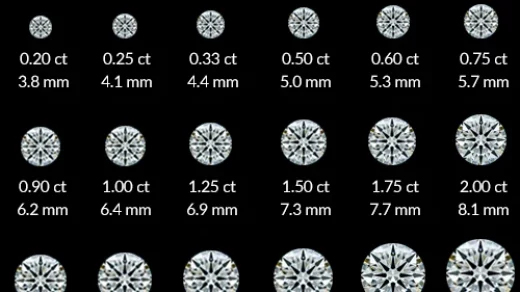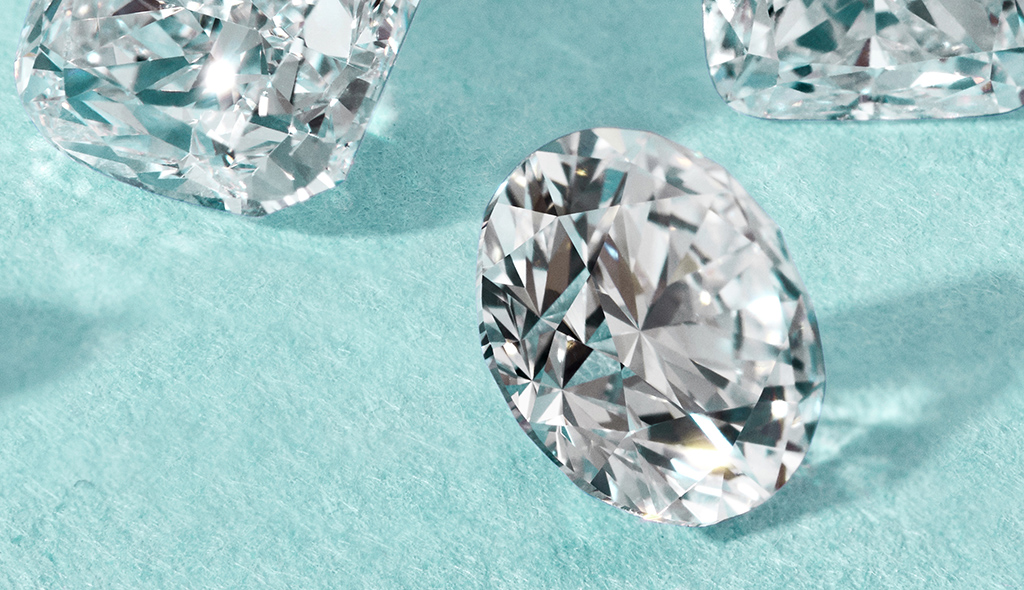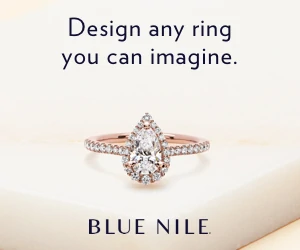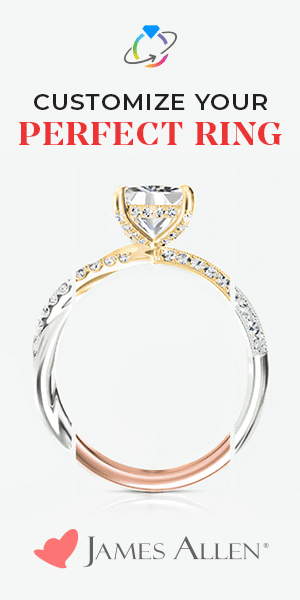A Guide to Diamond Buying: Key Considerations for a Brilliant Purchase
Introduction: Diamonds have captivated humanity for centuries, symbolizing everlasting love and timeless beauty. Whether you’re shopping for an engagement ring, anniversary gift, or a special piece of jewelry, the process of buying a diamond requires careful consideration. To ensure that you make an informed and satisfying purchase, here are key points to keep in mind when buying a diamond.
This guide is aimed at someone who is diamond shopping at Blue Nile.com
Use this button to automatically enter in all the settings mentioned in this article,
You can then adjust the carat, color and clarity parameters to fine tune it according to your preferences.
Read on to see why these settings are a good starting point.
A Quick Review of The Basics
If you are just getting started on your diamond search here are a few basics you will want to get antiquated with.
- The Four Cs:
- Cut: The cut of a diamond determines its brilliance and sparkle. A well-cut diamond will reflect light beautifully, enhancing its overall appearance. At the very minimum look for diamonds with an excellent or ideal cut. This increases your chances of finding something that will have great sparkle.
- Color: Diamonds come in a range of colors, with the highest quality being colorless. The Gemological Institute of America (GIA) grades diamonds from D (colorless) to Z (light yellow or brown). Choose a color grade that fits your preferences and budget.
- Clarity: Clarity refers to the presence of imperfections or “inclusions” in the diamond. Most diamonds have some imperfections, but they can be microscopic and not visible to the naked eye. Consider diamonds with a clarity grade of VS1 (Very Slightly included) if you want to avoid any chance of the inclusions being visible to the unaided eye.
- Carat Weight: Carat is a measure of a diamond’s weight and also, to a degree, its size, depending on the stone’s proportions. While larger diamonds are generally more valuable, it’s crucial to balance carat weight with other factors. Sometimes, a slightly smaller diamond with higher cut, color, and clarity can appear more stunning than a larger one.
- Certification:
- Always choose a diamond that comes with a reputable grading report from an independent gemological laboratory, such as the GIA or AGS for natural diamonds or , GIA, IGI, GCAL for lab created diamonds. These reports provide an unbiased assessment of the diamond’s quality characteristics based on the Four Cs.
- Shape and Style:
- Diamonds come in various shapes, from the classic round brilliant to fancy shapes like princess, emerald, or pear. Consider the recipient’s personal style and preferences when choosing the diamond shape. Each shape has its unique charm and character.
- Metal and Setting:
- The choice of metal for the setting, whether it’s white gold, yellow gold, platinum, or rose gold, can significantly impact the diamond’s appearance. Consider the recipient’s skin tone and personal style when selecting the metal. Additionally, the setting style, such as solitaire, halo, or three-stone, can enhance the overall aesthetic of the piece.
- Budget:
- Establish a realistic budget before shopping for a diamond. While it’s tempting to focus solely on carat weight, allocating funds to the cut, color, and clarity can result in a more balanced and visually appealing diamond.
- Ethical and Responsible Sourcing:
- Many consumers are now concerned about the ethical and environmental impact of diamond mining. Consider purchasing diamonds that are certified as conflict-free or from sources that adhere to responsible mining practices.
- Return Policy and Warranty:
- Ensure that the jeweler offers a clear return policy and provides a warranty for the diamond. This protects your investment and provides peace of mind.
Buying a diamond is a significant decision, and understanding the key factors that contribute to a diamond’s beauty and value is essential. By considering the Four Cs, certification, shape, metal, budget, and ethical sourcing, you can make a well-informed and meaningful purchase that will stand the test of time. Take your time, do your research, and choose a diamond that not only meets your criteria but also tells a unique and beautiful story.
Ok so let’s get down to the brass tacks.
How Do I Use The Advanced Filters at Blue Nile?
Below is an example of a search for a 1.5 carat eye clean natural diamond that really sparkles.
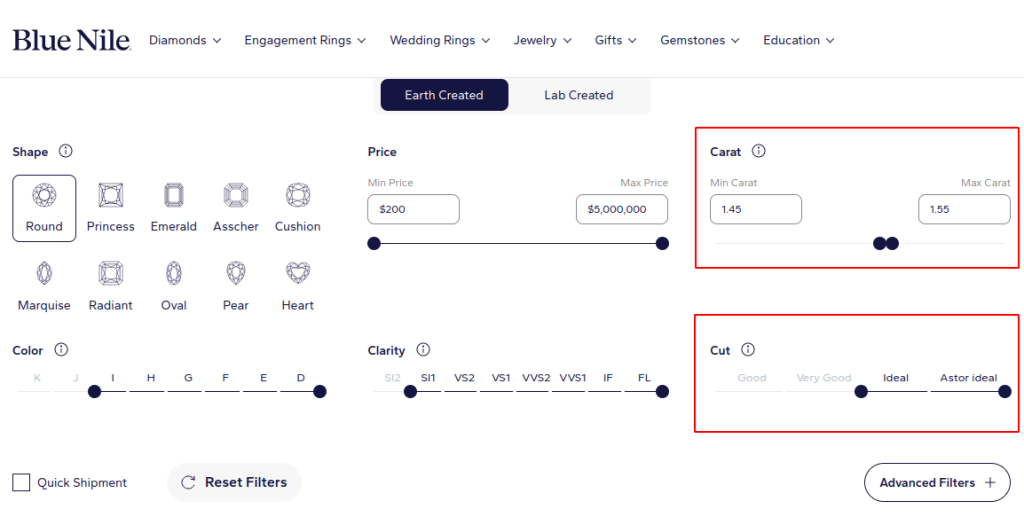
I’ve set the carat weight to .05 carats above and below the target of 1.5 ct, and moved the Cut slider to exclude Very Good.
Here are the first few results, none of which stand out as being particularly exceptional.
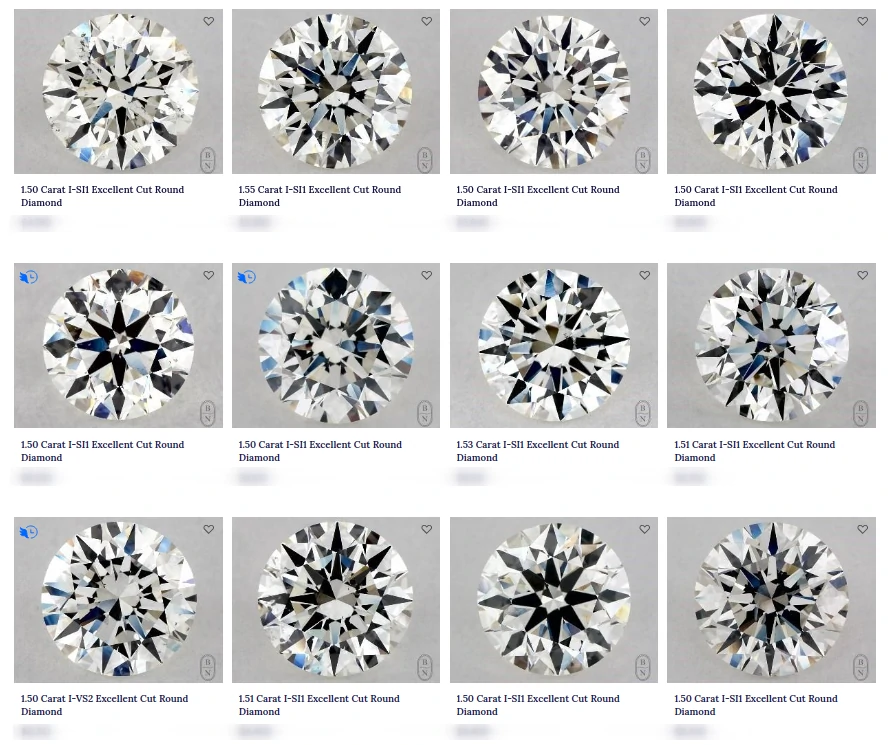
Let’s see how we can find tune our search results.
We will dive into the Advanced Filters to not only bring up more diamonds which are visually striking, we’ll see how to avoid stones which have less obvious undesirable properties.
For example the diamonds which show up in a search may have strong fluorescence or other characteristics which we don’t necessarily want even if they do have a striking appearance in the face up image.
Toggle all the Advanced Filters to Yes.
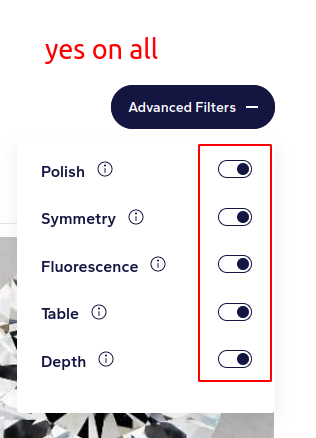
Polish is an important factor in making the diamond have a striking appearance so we will only select diamonds which have received an Excellent grade in that regard. Excellent Symmetry is important too as an asymmetric diamond renders the calculations useless as the reported angles often only apply to one side of the diamond. Fluorescence is discounted as there is a small risk of a diamond looking hazy in sunlight. Not all fluorescent diamonds will look hazy, but since we can’t take the diamond into the sun before buying we are going to avoid fluorescent diamonds for now. The table, if too large reduces the amount of fire produced so we will restrict the results to under 59%. The depth should remain under 62.7% so we don’t lose too much spread. These are slightly generous settings which we can narrow down if desired. But they will allow enough diamonds to be returned in a search which we can then whittle down until we find the perfect one for us.
Setting the depth to a maximum 62.7% and the table to a maximum 59% combined with Excellent symmetry already starts bringing up some more striking stones. Close to a third of the results are starting to look interesting. That’s a lot better than before we used any advanced parameters.
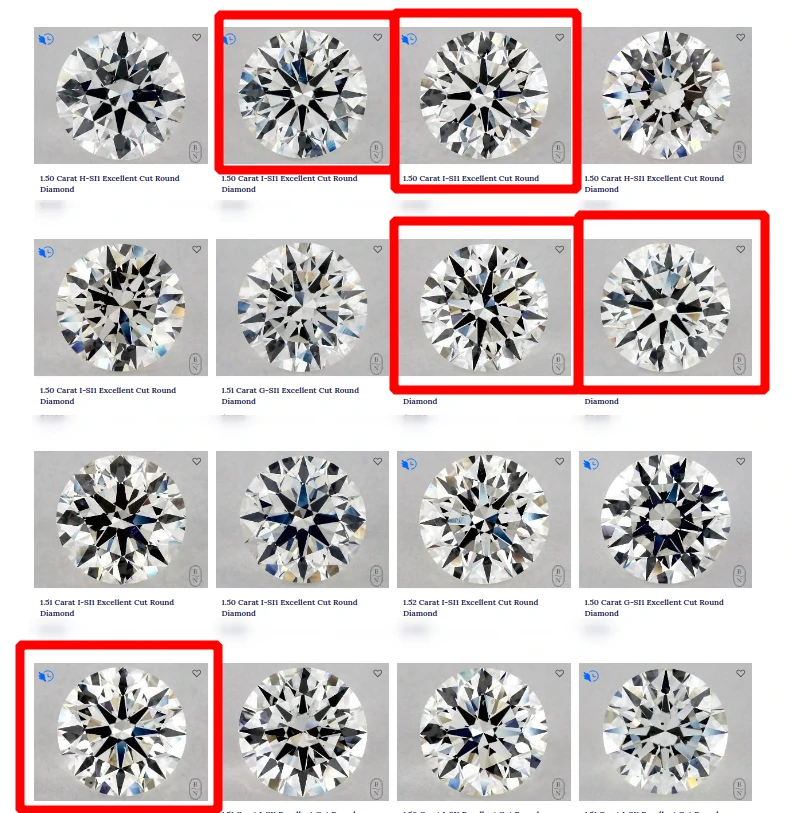
Which Color Grade Should I go for?
At this point the search results will show diamonds which vary widely in price. With the Prefilled Blue Nile Search button I’ve set the minimum color to an H color grade as I am trying to help my readers find a diamond which they will like upon receipt.
Some people don’t mind a bit of a warmer color and if that is the case for you by all means feel free to play with the color slider to include I, J or even K color grades. Just be aware that not all diamonds have yellow as their hue. Brown and green are definite possibilities. They are considered undesirable hues. You might be able to see the hue by viewing the 360° video though a side by side comparison helps make the diamond hue a little easier to see.
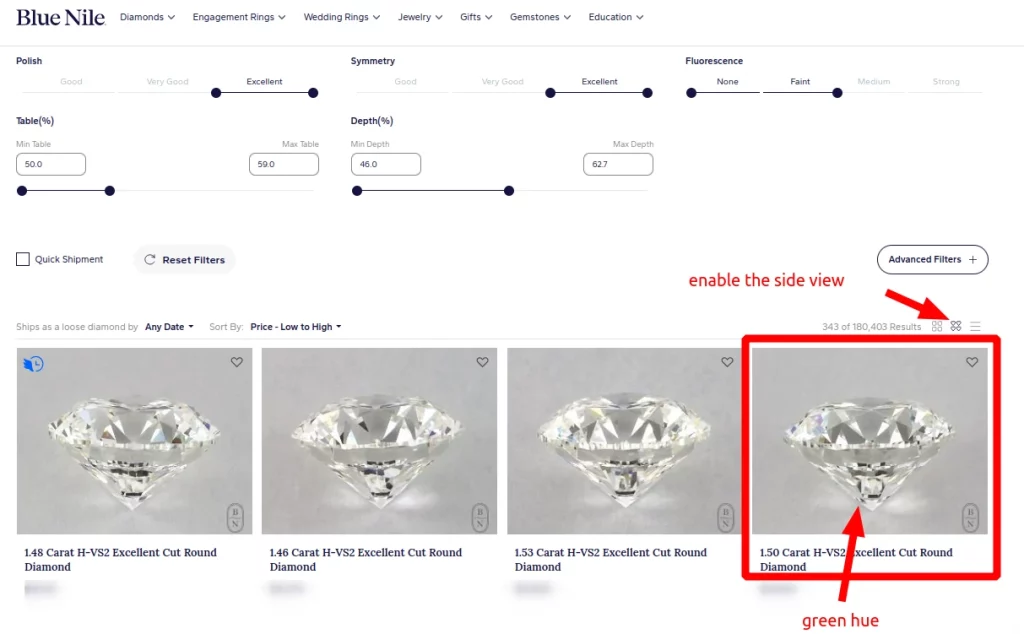
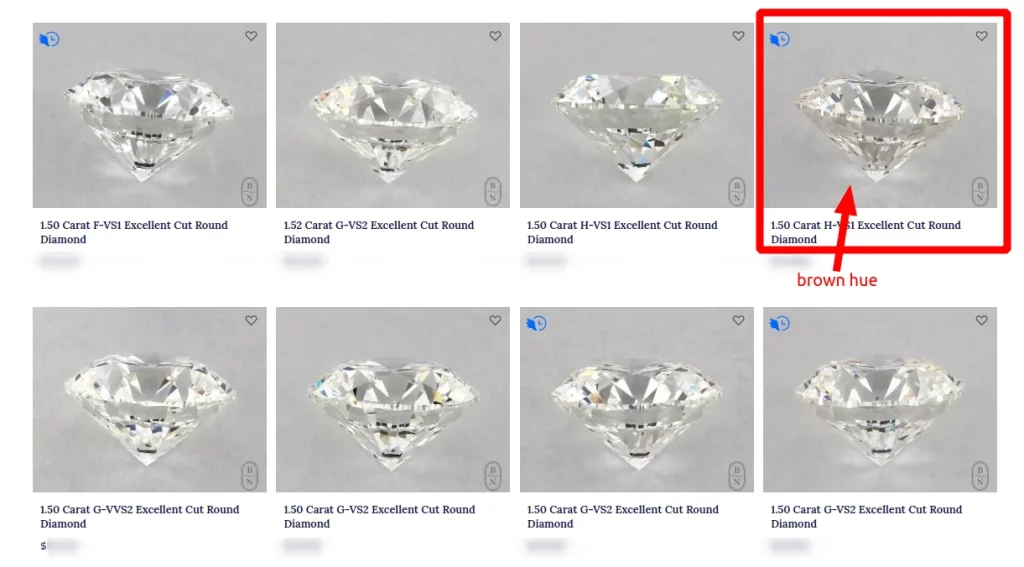
Unfortunately the hue is not something we can filter for in the search settings.
A stone may look like it’s cut perfectly in the face up view but it could be hazy and have a weird hue, like this one.
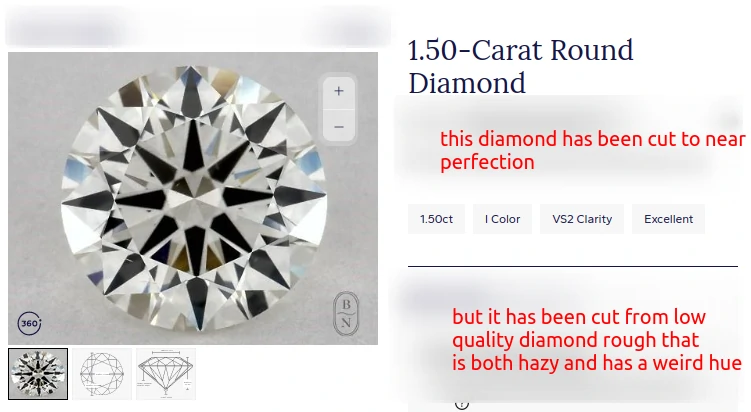
https://www.bluenile.com/diamond-details/15745490
The stone’s greenish gray hue becomes more obvious once you rotate the stone and view it from the side.
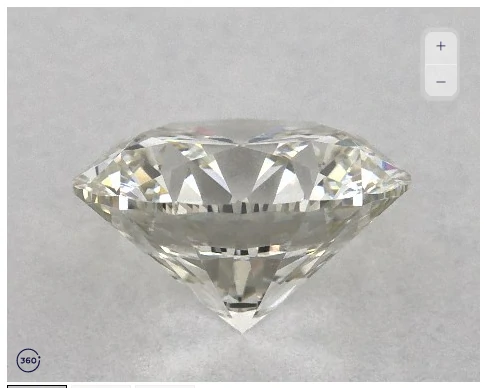
If you are worried about ending up with something that has a weird hue then keep to D-E-F graded diamonds where the color is so faint as to be negligible.
Clarity: How To Find Eye Clean Diamonds
I have previously written an article on how the term eye-clean is generally understood in an article titled What is an eye clean diamond.
This is not an industry term, and eye-clean doesn’t necessarily mean that you can’t see inclusions, but rather that you can’t see inclusions under normal circumstances when you aren’t looking very closely. Many diamonds which will be declared eye-clean may seem like they do not hold up to the definition once you know where the inclusions are and examine the diamond very closely.
With access to high definition 360° images comes the added burden of knowing where the inclusions are and once you know where to look it can be something that bothers you when you receive the diamond.
So, where is the sweet spot for eye-clean diamonds which are a little more affordable, all else being equal. Is it SI1? is it VS2?
A lot of diamond experts will agree that VS2 is the sweet spot where you aren’t paying for clarity characteristics which have little bearing on the visual aspect.
Are all VS2 graded diamonds eye-clean? No but there are plenty around. Please keep in mind that I am only referring to GIA graded diamonds here. Other grading labs may have a small or great divergence in their clarity grade definitions. EGL, another lab that grades diamonds, is in their own universe here and I demonstrate the fact in an article titled The Important Difference Between GIA and EGL Graded Diamonds. IGI, which is yet another grading laboratory, seems to be only about a grade off, but I wouldn’t recommend IGI for natural diamonds. IGI has excelled more in the lab grown diamond area, even though the clarity grade issue still applies: IGI’s VS1 is what I consider to be the sweet spot for IGI graded lab created diamonds.
SI1 diamonds are rarely eye-clean, and even if they are eye-clean may have other issues such as excessive clouding, invisible fractures called feathers, or other structural issues.
Feathers and twinning wisps near the girdle are weak points where the diamond can be susceptible to damage if it strikes against another diamond at just the right angle. You may think this will never happen to you, but throwing a diamond ring into the jewelry box where it strikes against other diamond jewelry is more common than you think.
I usually begin a search with VS2 set as the minimum clarity. From there I look at the comments on the grading report, check the clarity characteristics plotted in the diagram and closely examine the 360° video.
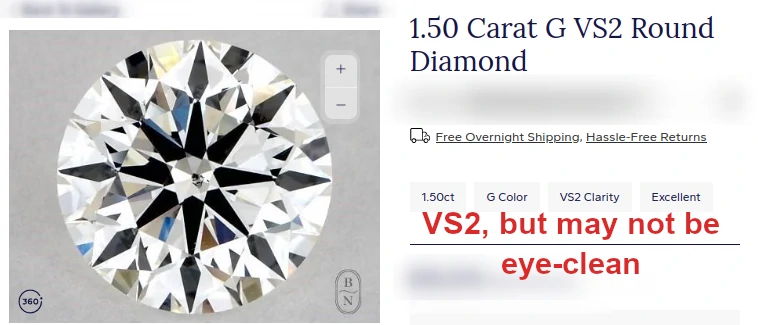
https://www.bluenile.com/diamond-details/15745433
This one is borderline eye-clean. Some jewelers may say this is “eye-clean”, others may disagree. It should technically fit the definition I gave earlier, but if you have very good eyesight and know where to look, once you see the inclusion right in the middle of the table, you can’t unsee it.

